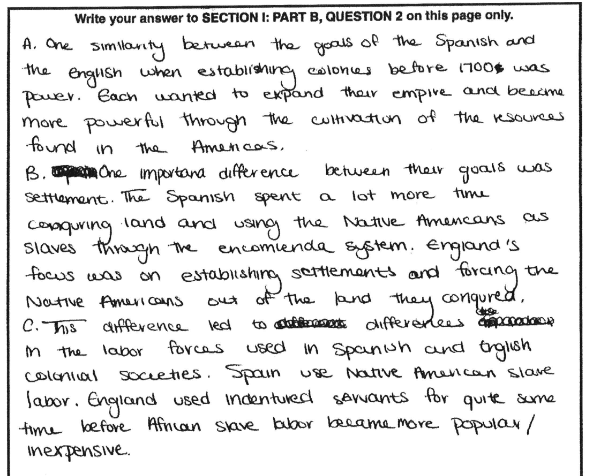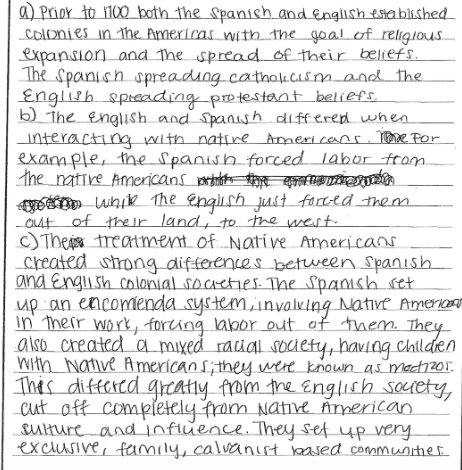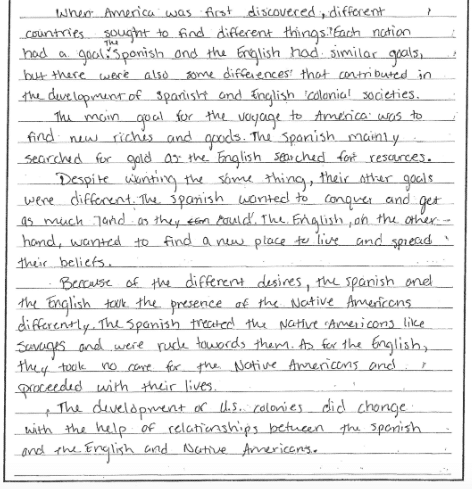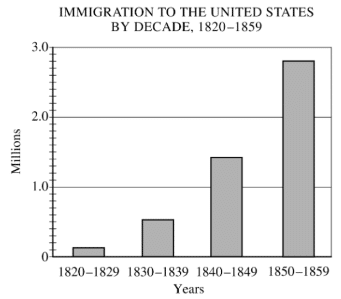At this point, you have done all the studying, you know your topics, and you’re ready to tackle the APUSH exam. But there’s just one small problem: how do you take the test?! More specifically, how do you answer APUSH short answer questions, one of the most recent additions to the exam?
In this blog post, I will outline what APUSH scorers are looking for from past tests and give student examples. All of this information is available on the College Board website, which I encourage you to use as a resource for your studying.
The format of this blog will be as follows: I will give you one example question and break down three student responses. I will then present a new question, and provide a link to the information so you can score yourself on your short answer responses. Sound good? Let’s get started!
APUSH Short Answer Questions: Question 1
The first of our APUSH short answer questions is taken from the 2016 exam. Again, all of the content presented on this blog is available at the College Board website.
The question asks you to answer parts (a), (b), and (c):
a) Briefly explain ONE important similarity between the goals of the Spanish and the English in establishing colonies in the Americas prior to 1700.
b) Briefly explain ONE important difference between the goals of the Spanish and the English in establishing colonies in the Americas prior to 1700.
c) Briefly explain ONE way in which the difference you indicated in (b) contributed to a difference in the development of Spanish and English colonial societies.
Now, before you walk off and throw your hands up in the air because this seems impossible, let’s walk through what the question is asking you to do.
- First, identify the time period of interest. For this question, you should only be looking at the colonies prior to 1700. We are talking early, early U.S. history here.
- Next, identify the region of interest. Again, we are talking about the colonies that would eventually become the United States (not NECESSARILY the thirteen original colonies). Notice, though, that the question is not asking about the colonists themselves but the goals of the empires the colonists came from: Spain and England.
- Finally, identify the type of response requested. In parts A and B, you are being asked to compare and contrast by identifying similarities and differences. This is a completely different question than a cause/effect or change over time type question, so you should be answering the question in a way that makes it clear that you can compare and contrast. Notice, though, that in Part C, you are to explain how the difference in Part B caused a difference in the development of the two societies (a cause/effect question).
Let’s see how other students responded to the question.
Example Student Response #1
Let’s look at our first student example from the College Board website.

What score do you think this student received? Well, let’s break it down some more.
Part A
Part A asks you to explain ONE similarity in the goals of the Spanish and the English in the American colonies prior to the 1700s. This student identifies one similarity here: power. Although it’s not very specific (the fact that “each wanted to expand their empire and become more powerful through the cultivation of the resources found in the Americas” could apply to just about any colonial relationship), it does outline a similarity. Student: 1 point.
Part B
Part B is asking you to do the opposite of Part A: that is, explain ONE difference. Here, the student becomes more specific in highlighting different settlement patterns. The Spanish used the encomienda system, which enslaved indigenous peoples, whereas the English forced indigenous peoples off the land. (Notice, too, that this could have been a similarity as well: the mistreatment and oppression of indigenous peoples.) The student gets a point here, too.
Part C
Here is where an important shift occurs. You are no longer answering a compare/contrast question and, instead, are looking at a historical causation question. No problem; you got this.
In the student example above, the student does give a difference in the development of the labor force in the two societies. It is a simplistic response that does not get into very many specifics, but it answers the question that was being asked. And guess what? The student got a point here too.
Reflection
So what can we learn from looking at this response? Here’s what you should keep in mind when answering APUSH short answer questions:
- Identify what it is you need to answer.
- Answer the question being asked.
- FOR SHORT ANSWERS ONLY: Be specific when necessary. After all, you only have a limited number of space and time to demonstrate your understanding.
Example Student Response #2
Let’s see if you can apply what you have learned to the following student response.

The student response above lost a point. Can you guess where?
It’s actually on Part B!
The student did not frame the response in terms of goals, something that was explicit in the question. As noted above, answer the question you are being asked.
Example Student Response #3
Let’s try one more student response on this question.

What score would you have given the above student response?
The APUSH scorers gave this student 1 point, for accurately identifying a similarity between the English and the Spanish (“new riches”), but the student did not receive any credit for Parts B and C.
Why not?
First, for Part B, this is an inaccurate claim about the goals between the English and the Spanish. It goes without saying that if you make a statement not supported by the facts of history, you will not get credit. Finally, Part C continues making what the APUSH scorers called “erroneous claims” because it was based on the inaccurate statements of Part B.
As the first example showed, you don’t have to be super specific to get full credit. But you do have to be correct. So, instead of making lofty-sounding statements about motivations, make simple statements that you can be specific about, should you need to be. That’s the difference between scoring a 3 and a 5 on the APUSH exam.
Scoring Notes
It’s always SUPER helpful to look at the scoring notes for APUSH short answer questions. These notes tell you all the acceptable answers that are possible.
a) Briefly explain ONE important similarity between the goals of the Spanish and the English in establishing colonies prior to 1700.
Examples of responses to (a) that would earn the point:
- To acquire wealth
- To increase power, pride, prestige of the Spanish or Englishs crowns
- To promote religion
- To find access to Asia
b) Briefly explain ONE important difference between the goals of the Spanish and the English in establishing colonies.
Examples of responses to (b) that would earn the point:
Spanish:
- More intent on religious proselytizing (spread Catholicism)
- More interested in glory (power of Spanish Crown)
- More openly interested in achieving individual fame and glory of conquistadores
- More interested in establishing and protecting trade networks and routes
- Colonization more directed by central government
English:
- Pursued a wider range of goals, including religious settlement and economic gain (e.g., extractive industries and farming/fishing/forests/fur)
- More willing to allow bases for privateers
- More motivated by imperial competition with Spain and other nations
- More likely to be fleeing from political and religious conflicts
c) Briefly explain ONE way in which the difference indicated in (b) contributed to a difference in the development of Spanish and English colonial societies.
Examples of responses to (c) that would earn the point:
- England more likely to allow private individuals and joint stock companies to colonize in the name of England.
- Spanish developed extractive industries in precious metals, whereas English were more likely to establish economies based on trade.
- More royal control over Spanish colonies than English because English were settled to escape political and religious persecution.
- Many English colonists tended to establish more permanent settlements than the conquistadores. However, the Spanish eventually established permanent settlements.
- Because Spaniards were more concerned with conversion, they eventually integrated indigenous peoples into their culture, albeit not equally.
- English were more concerned with excluding indigenous peoples from colonial society so they were more likely to dislocate them from their lands.
- English were more willing to embrace diverse labor systems (indentured servants, enslaved African Americans).
- The encomienda system developed as a Spanish labor system, which also reinforced efforts to instill Catholic religious practices in Native Americans.
- The English developed diverse labor systems (indentured servants, enslaved African Americans).
APUSH Short Answer Questions: Question 2
Now, it’s your turn. Take your time to go through the steps of figuring out what you are supposed to answer before you tackle this question.
After you have written your response, check your response against the student responses and score notes that are listed on the College Board website. This short answer is taken from the 2016 exam and is listed as Short Answer Question 1. Good luck!

The question asks you to answer parts (a), (b), and (c):
a) Briefly explain how ONE major historical factor contributed to the change depicted on the graph.
b) Briefly explain ONE specific historical effect that resulted from the change depicted on the graph.
c) Briefly explain ANOTHER specific historical effect that resulted from the change depicted on the graph.




